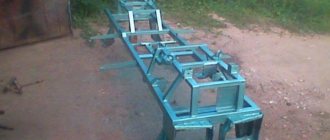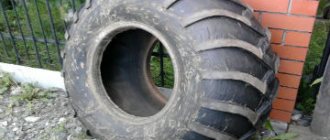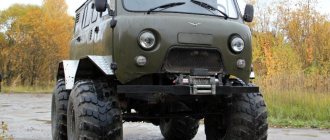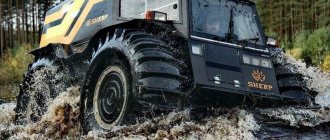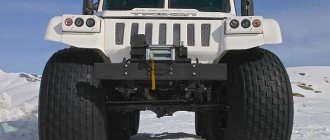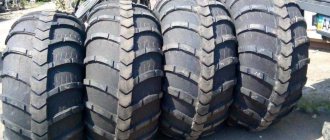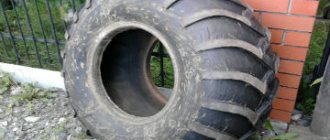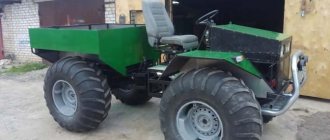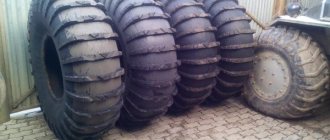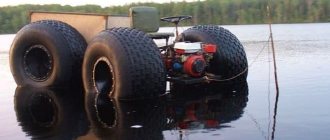Homemade all-terrain vehicle “Svyatogor” on low-pressure tires with independent suspension, made from an Oka car: photos of production and video testing of the all-terrain vehicle.
Dear readers, we present to your attention a wheeled all-terrain vehicle with low-pressure tires.
The body, engine and calipers were taken from the Oka, the axles were taken from LUAZ and redone, the transfer case, CV joints, flanges were from the Niva, the VAZ-2109 hub, tires from the Urals, inner tubes from T-150 wheels.
The photo shows the main stages of manufacturing an all-terrain vehicle. The frame is welded from a profile pipe.
Frame manufacturing process, profile pipes used:
- 40 x 60 mm – 12 meters.
- 25 x 40 mm – 3 meters.
- 10 x 10 mm – 3 meters.
The design uses independent suspension.
At the initial stage, the author installed cameras from T-150 wheels on the all-terrain vehicle.
The engine is mounted longitudinally to the all-terrain vehicle frame, the differential is locked.
Subsequently, the author removed the cylinders and installed “flat” tires, the wheels were welded from GAZ wheel rings, the author took the tires for the all-terrain vehicle from the Urals and slightly improved them by cutting out a new tread, which made the wheels themselves much lighter.
The figure shows the gear shift diagram of the all-terrain vehicle.
The weight of the all-terrain vehicle is small, less than one ton, which allows it to easily move over rough terrain; on a flat road Svyatogor reaches a speed of more than 60 km per hour.
Here in the photo the author has already replaced the tubes with “flat” tires.
Trailer for transporting an all-terrain vehicle.
I recommend watching an interesting video of what an Oka-based all-terrain vehicle is capable of.
Source samodelki-n.ru
Lightweight all-terrain vehicles with huge cameras are able to overcome severe off-road conditions that other types of off-road vehicles cannot traverse. Self-made vehicles of this type are simple, since they do not have a complex technical base, which is why they have won the recognition of most home craftsmen. Such equipment is especially in demand by residents of rural areas, where precipitation greatly reduces the quality of roads, as well as by lovers of hunting, fishing and extreme recreation.
Types of homemade all-terrain vehicles
Depending on the type of design and chassis, the following types of homemade all-terrain vehicles differ:
- Swamp boats. They have a simple design and are relatively cheap to manufacture. They are equipped with an outboard motor and allow you to move around shallow bodies of water.
- A caterpillar swamp vehicle allows you to drive through overgrown bodies of water, but it is quite complex and expensive to manufacture, as it requires the attachment of a special type of tracks.
- An all-terrain vehicle with low-pressure tires is the simplest and most promising type of swamp vehicle, the performance of which depends on the design and reliability of the tires.
Some homemade products later become serial models. This happened with Alexei Garagashyan’s all-terrain vehicle called “Sherp,” which is now known all over the world.
Homemade swamp rover project
Since the machine will be assembled from available materials and mechanisms, drawings of the swamp vehicle will have to be created in parallel with the purchase of the necessary components - rolled metal, engine, etc.
Obviously, you first need to sketch a rough sketch, which will reflect the main technical solutions, and in accordance with it, select the required metal, engine and complex chassis mechanisms. You can, for example, use the advantages of caterpillar tracks. Huge low-pressure wheels also have their advantages.
Only when the material has basically been collected can you begin to draw up a drawing with the exact dimensions of all parts.
Types of homemade all-terrain vehicles with low pressure tires
Homemade all-terrain vehicles on low-pressure tires, having the same principle of off-road movement, may differ in type of design. There are the following main types of vehicles of this type:
1. All-wheel drive caracat . In its design, it uses transmission and chassis elements from outdated types of passenger cars. It has all-wheel drive, a transfer case, and the adapted boat hull in its lower part and the tightness add buoyancy to the all-terrain vehicle. Designed to overcome swamps and swamps, it is capable of delivering cargo and people to areas inaccessible to ordinary SUVs.
2. Tricycle on low pressure tires . It has a very simple design and can be made by almost any car enthusiast in a garage. The IZH Planet 3 motorcycle is often taken as the basis for such an all-terrain vehicle, due to its endurance and unpretentiousness.
3. Homemade karakat with an SZD motorized stroller engine . Its peculiarity is that the engine is located not under the frame or gas tank, but under the seat or in the rear of the all-terrain vehicle’s frame. Chassis parts are traditionally taken from cars, and elements of motorcycles are used in the front part. Pipes, channels and angles are used to make the frame.
4. All-terrain vehicles with low-pressure tires based on cars or ATVs . They are manufactured using ready-made main units by reworking the transmission and chassis, as well as equipping them with low-pressure tires.
Materials and mechanisms
The reliability of the entire machine will depend on the strength of the structure. Need to purchase:
- Rolled metal – angle, pipe, medium-sized channel, steel sheets;
- You can try to use an old frame from a used SUV;
- Powerful engine;
- Tracks or large wheels, which depends on the type of chassis;
- Steering.
How to make an all-terrain vehicle on low-pressure tires?
Work on manufacturing an all-terrain vehicle begins with drawing up an action plan, the full implementation of which means achieving the desired result. The following tips will help you save time and money:
- Availability of free time, allowing you to regularly carry out work on assembling the all-terrain vehicle. If it is absent, it is better not to start at all.
- Budget planning. Creating an all-terrain vehicle yourself allows you to save on purchasing a production model, but in order to eliminate unnecessary expenses, you need to make all the calculations and buy the necessary components and parts, and also leave a certain amount for unforeseen expenses or breakdowns.
- Developing a plan. If you have experience in developing vehicles or the inclinations of a design engineer, it is possible to independently create a drawing of an all-terrain vehicle. In the absence of such, they use other people’s experience and ready-made drawings, of which there are a sufficient number on the Internet.
DIY low pressure tires
Tires of this type visually resemble huge pillows that support the entire structure. The degree of grip in such wheels allows the vehicle to be passable on any off-road terrain. Depending on the design features, such tires are divided into the following types:
- Arched. They are 5 times larger in size compared to a standard wheel, and have a thickness of up to 700 mm. The pressure in them is like in a regular ball - 0.05 MPa. Installed exclusively on the drive drive.
- Wide-profile. They are distinguished by an oval design and pressure up to 2 times lower than standard. Most often used in lifting vehicles.
- Toroidal. They are manufactured in tube and tubeless versions and are highly popular among car enthusiasts.
- Pneumatic rollers , having lugs to improve cross-country ability, and ribs to increase rigidity, giving the entire structure stability and strength.
The cost of factory-made low-pressure tires may be unaffordable for many car enthusiasts. But for your own all-terrain vehicle, it is quite possible to make such a wheel yourself. The work is performed in the following order:
1. Selection of source material, for example, agricultural or aircraft tires, as well as other types of industrial transport.
2. The tread is cleaned, washed and dried, after which the desired patterns are drawn to create your own design, as well as to remove excess wire and rubber.
3. To remove excess wire, the inner part of the wheel is trimmed and the cord is removed using a winch.
4. Excess rubber is also removed with a winch, making cuts around the circumference, and securing them to the cable with pliers, carefully pulling them and cutting them with a knife.
5. After removing the tread layer, the surface is cleaned with sandpaper.
6. Disk assembly. To do this, use a standard disk cut in half, or welded from plates and pipes, and then carefully polished to prevent damage to the camera.
7. The tire is pulled onto the rim and secured with belts or a fire hose, and then inflated. The wheel is ready.
What type of tread should I choose for an all-terrain vehicle?
To select the right type of tread for an all-terrain vehicle with low-pressure tires, you need to consider the following factors:
- The protector must have the ability to self-clean. This property is especially important for using an all-terrain vehicle in harsh and wetlands.
- When using an all-terrain vehicle on peat bogs, choose tires with low and shallow terrain, otherwise if their top layer breaks, the grip will be insufficient for full movement.
- When used in snowy areas and on sandstones, tires with a rare pattern are chosen.
Wheel for swamp vehicle
To make all-terrain wheels, you need to find 4 large-diameter tires and cut out a lot of windows in them on the sides and the supporting surface.
You should get an openwork lattice structure made of rubber. A camera is inserted inside the resulting frame and inflated.
Choosing an engine for an all-terrain vehicle
Most often, the following types of engines are used as a power unit for self-manufacturing an all-terrain vehicle:
- Motorcycle.
- ZAZ car.
- Motoblock.
- Domestic cars.
The presence of a specific engine in an all-terrain vehicle does not make a fundamental difference. It is more important to take into account such a feature as ensuring its sufficient cooling , since the vehicle is operated all year round in different temperature conditions and at low speeds. The ZAZ engine is excellent for this, as it can withstand temperature changes well. All-terrain vehicles running on motoblock power units have also proven themselves to be the best.
Another main criterion for choosing an engine for a future homemade product is its power .
The power reserve must be sufficient so that an all-terrain vehicle on low-pressure tires can get out of mud, water, or deep snow.
By choosing a unit with a power reserve, you get better performance, prevent overheating and create conditions for the longest service life.
Features of the all-terrain vehicle chassis
The chassis of all-terrain vehicles on low-pressure tires is made in the form of an independent suspension to give the all-terrain vehicle better cross-country ability, increase the comfort of driving the vehicle and make riding easier for the driver and passengers. This type of design has a main drawback - the complexity of manufacturing.
To create it, pipes, angles and channels made of durable alloy steel are used, creating a strong base that can last for several years without breaking. The frame is made both solid and articulated. The latter has a high working potential, but the complexity of its manufacture makes it quite rare in home-made designs.
Sequence of self-assembly of an all-terrain vehicle
Assembling an all-terrain vehicle on low-pressure tires includes the following steps:
1. Selecting the type of all-terrain vehicle and the base on which the units and parts will be mounted. For this, frames of cars or motorcycles are used, as well as home-made structures developed on their own or borrowed from someone else’s drawings.
2. Manufacturing and assembly of suspension with rear axle. For this, the optimal solution is an independent design , and although much more time will be spent on its creation, the end result will be an all-terrain vehicle with higher cross-country ability and ride comfort.
3. Installation of wheels. Performed after completion of work on the rear axle and suspension. Metal hubs are used to mount the cameras. Properly manufactured or selected low-pressure wheels will provide the all-terrain vehicle with increased driving safety and good handling.
4. Engine installation. Particular attention is paid to the correct design of the cooling system.
5. Installation of additional systems. Includes connecting the brake system, exhaust gas communications, clutch and electrical equipment. At this stage, the body of the all-terrain vehicle and lighting fixtures are installed.
6. Completion of work and implementation of a trial test, which shows the performance of components and systems. If there are problems or points that need to be improved, the shortcomings are eliminated, after which the all-terrain vehicle is ready for use.
Source voditelauto.ru
Homemade all-terrain vehicles and other off-road vehicles are often made on the basis of a walk-behind tractor. There are several reasons for this:
- there is an energy-rich transport unit with high traction characteristics, assembled on a frame;
- engine and transmission controls have been moved to comfortable handles;
- The weight of walk-behind tractors is low; they can be transported to the desired location in the trunk, body or on a car trailer.
For hunting and fishing, a lightweight mini all-terrain vehicle is quite in demand. But the industry has not yet seen commercial prospects in creating sets of attachments that convert a serial walk-behind tractor into an off-road vehicle. There are quite interesting examples of the creation of such machines. Do-it-yourselfers created role models with their own hands. There is room for ideas when developing new interesting devices.
Necessary tool
Mechanics who undertake to develop and assemble homemade swamp vehicles obviously already have a full set of wrenches, screwdrivers, files, a metal saw, pliers, pliers, and a variety of fasteners of popular sizes.
You will also need a soldering iron, a welding machine, and a pump for inflating large wheels.
Features of all-terrain vehicles made from a walk-behind tractor
The main components that you should purchase or make yourself for a vehicle based on a walk-behind tractor:
- frame, it serves to organize a mobile vehicle;
- the rear axle is needed to install the rear wheels;
- a seat for the driver, it is advisable to protect it from moisture and dirt from under the wheels;
- A lighting system is needed to move safely at any time of the day.
An all-terrain vehicle based on a walk-behind tractor is created as a single-seater vehicle. Its load capacity should be about 200 kg. The width is calculated based on the conditions of resistance to rollover, usually it is 1100 mm or more.
Modern walk-behind tractors Neva, Ugra, MTZ and others are equipped with engines with a power of more than 10 hp. This power is enough to move at speeds of more than 10 km/h. On off-road roads, when passing through mud or swampy places, the speed may decrease to 1-2 km/h.
Installation
The swamp vehicle must be assembled according to a pre-developed algorithm.
How to make a swamp vehicle with your own hands:
- A frame and shock-absorbing springs are assembled from parts prepared to size.
- The body of the swamp vehicle is installed.
- The engine is installed and connected to other functional units.
- Wheels or rollers with tracks are installed.
- The interior decoration is being carried out.
How to make a homemade wheeled all-terrain vehicle
An example of a drawing of an all-terrain vehicle on low-pressure tires
It makes sense to equip the basic unit with a reduction gearbox. The reason is that gasoline and diesel engines have the best torque performance at a crankshaft speed of approximately 75-85% of the maximum.
The engine must have a forced cooling system. When driving at low speed, the oncoming flow will not be enough to maintain optimal thermal conditions.
All-terrain vehicle frame
An example of a frame-fracture drawing
A frame is created between the front and rear axles. It is better to use profile pipes of rectangular or square cross-section as the basis. They provide greater rigidity than rolled angles, channels and I-beams of the same mass.
The joining of the frame elements of a wheeled all-terrain vehicle can be rigid, then it will be formed in a single-volume format. When using heavy Neva or MTZ walk-behind tractors, this option will be preferable.
As an option, a breakable frame (fracture) is made; this option is used for areas with a complex profile. Here the articulation is performed through the kingpin. The front and rear axles have independent suspension from each other. Craftsmen create such all-terrain vehicles based on the Neva and Ugra walk-behind tractors.
For hunting and fishing, it is better to have a wheeled all-terrain vehicle with a breakable frame. Its maneuverability is higher than when using a rigid frame design.
Rear axle and suspension of a homemade all-terrain vehicle
To simplify the design, some DIYers use a ready-made rear axle from a passenger car. For example, from the Moskvich-412 car: its low weight allows installation on a light all-terrain vehicle. The suspension is performed on shock absorbers for a smooth ride and reduced vibration.
Other craftsmen make independent suspension on each rear wheel. This approach is implemented on the Ant scooter. When driving, a slight rocking is felt, at the same time the wheels experience less resistance on uneven surfaces, and fuel consumption is noticeably reduced.
The rear axle is connected to the frame with long, hardened bolts. For elastic joints, rubber inserts are used, for example, silent blocks. This improves the performance characteristics of an all-terrain vehicle based on a walk-behind tractor.
The rear axle on skis is used in winter. The resistance to movement is minimal, the design is greatly simplified.
Wheels (low pressure chambers)
To move on wet and unstable ground, you can use lugs. They provide high grip. Large-diameter low-pressure chambers perform even better. Pneumatics have minimal ground pressure, and the presence of air contained in the all-terrain vehicle’s chambers will make it possible to create a floating all-terrain vehicle.
For installation on the rear axle, homemade or special wheels for all-terrain vehicles, swamp vehicles and snowmobiles are used. They can be purchased assembled or as separate elements: tire, tube, disc. The wheel is easy to assemble.
- Homemade discs for pneumatics are made by welding ordinary discs and mounting plates using metal tubes. This expansion is necessary in order to adjust the small diameter of the car rim to large cameras and better fix them.
- A large camera is placed on a specially expanded disk - either a proprietary one or from other units (GAZ 53, Ural, Kamaz or another truck, an aviation camera, etc.).
- An air valve is installed in the hole of the disk.
- The wheel is inflated with air.
- The resulting tires are installed on a homemade all-terrain vehicle.
You can increase the cross-country ability of regular wheels on low-pressure chambers by creating an additional tread. For example, additionally secure the cameras with chains, conveyor belts, homemade tracks or another method.
Another option is to cut a patch lug from the tire. The depth of the structure’s hook reaches more than 20-25 mm. Rolling resistance increases, while at the same time the slip coefficient decreases sharply.
Assembling a homemade all-terrain vehicle from a walk-behind tractor
When all the tools, spare parts and components are prepared, you can begin assembly. This is a rough plan for how to assemble a homemade all-terrain vehicle, it all depends on the chosen design.
- A walk-behind tractor is installed on a welded or finished frame.
- The rear axle and, if necessary, the front axle are mounted.
- The seat is placed on the frame.
- If provided in the drawing and diagram, the steering control is installed.
- The protection is attached to the frame; it is made of plastic or metal sheet.
- The future driver should try out the comfort of the seat; if necessary, provide auxiliary devices for adjusting the seat.
- The functionality of the brakes is checked.
- Electrical circuits and lighting fixtures are installed.
As individual elements and assemblies are manufactured, their performance is checked. A fivefold safety margin is provided here.
After completing the bench tests, they begin the field tests. You need to know how the car behaves in difficult conditions.
Other equipment equipped with tracks instead of wheels
Homemade tracked and wheeled all-terrain vehicles from Oka
If you look at it, you can put any equipment on tracks, regardless of its purpose. And if previously only garage craftsmen, of whom there are a great many in Russia, were engaged in such “experiments”, today you can see similar factory-produced equipment.
Not only snowmobiles and swamp vehicles are equipped with tracks, but also mini-tractors, which were not originally intended for these purposes. But production vehicles mounted on caterpillar tracks are of particular interest.
PHOTO: rosvezdehod.ru Swamp vehicles are very popular among hunters and rangers
Tracked vehicle: buy or make it yourself
If we think from the point of view of economy, then making tracks for a car yourself is more acceptable. However, in this case, you should be prepared for the fact that you will have to frequently repair it in the field. But there are also advantages - several breakdowns, and the garage technician knows all the weak points, after which he strengthens them.
The factory version is more expensive. But here you can rely on the tests carried out. Although, as practice shows, even such tracked units break at the most inopportune moment. We invite you to watch a video in which a Niva is installed on tracks (though not with your own hands, but in a factory setting).
Watch this video on YouTube
DIY snowmobile tracks
A snowmobile a priori must be equipped with tracks - without this it will not be able to move. However, the problem is that they can fail.
In this case, there are 3 options for the development of events.
- If you have time and desire, it is quite possible to use a conveyor belt as a homemade track for a snowmobile. The main thing is to firmly sew the ends and strengthen the sides so as not to remain in some snowdrift away from people when the connections are broken. In winter forest conditions, repairing a snowmobile track with your own hands, although possible, is problematic.
- Contact craftsmen, who can always be found in garage cooperatives.
- Purchase new tracks from a specialty store. This option is good, but it can make a hole in the family budget.
PHOTO: nifhi.mrc51.ru Such tracked snowmobiles are assembled by craftsmen
Homemade mini-tractor on tracks: what to make with your own hands
The best mini-tractor can be called a modernization of a walk-behind tractor. If the owner does not want to install it on a crawler track himself or simply does not have time for this, it is quite possible to purchase the necessary components.
And after the tracks for the Neva walk-behind tractor or any other have been purchased, you can attach various attachments to it (plow, hiller, flat cutters). Prices for small tracks for walk-behind tractors are not too high, unlike long elements used in larger equipment.
We invite you to see in the video review how a walk-behind tractor on tracks looks and works.
Watch this video on YouTube
Homemade all-terrain vehicle with caterpillar tracks: do-it-yourself swamp vehicle
All-terrain swamp vehicles are a completely different story. For many hunters and fishermen, making an all-terrain vehicle from a walk-behind tractor (Neva or any other) today remains the only option. Not everyone can afford the purchase of such equipment. In addition, it is easier to repair a home-made unit on the road if you assemble it yourself, piece by piece.
We bring to your attention several photographic examples of interesting homemade products from walk-behind tractors and chainsaws mounted on caterpillar tracks.
PHOTO: hewic.ruvegity.ru.net PHOTO: guns.allzip.org Well, now – a bonus: several photographs demonstrating the height of the imagination of our craftsmen and examples of bringing it to life.
1 of 6
PHOTO: forum.sakh.com PHOTO: youtube.com PHOTO: forum.sakh.com PHOTO: youtube.com PHOTO: twitter.com PHOTO: avatars.mds.yandex.net
